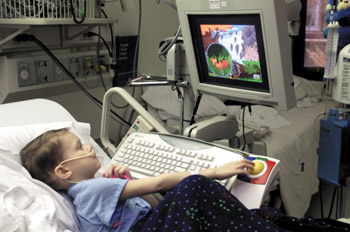
Devin Proctor, 5, uses a Reader Rabbit program on a bedside computer in Vanderbilt Children's Hospital. (photo by Dana Johnson)
Children’s Hospital computer project links kids to outside world
An ambitious project to place computers and internet access within reach of many patients in Vanderbilt Children’s Hospital is well underway.
The project is the brainchild of Dr. William Stead, associate vice-chancellor for Health Affairs and director of the Vanderbilt Informatics Center. Stead had a vision of allowing children and their families easy access to computers, software, and the internet. Armed with that vision and funds from the Waitt Family Foundation and the Jack C. Massey Foundation, Stead has seen the project take root.
In just over a year, the computer project internally dubbed “Firefly,” has seen placements of computers in three Children’s Hospital public areas, as well as five on specially designed computer carts in the Mylo-Suppression Unit. A full-time child life specialist has been hired to work with patients and families to continue to develop and implement the project.
What sounds like a simple task – buy some computers and place them in the Children’s Hospital – has actually been challenging and complicated. Challenges have included everything from infection control issues to gaining access to a computer from the hospital bed. The project team knew there would be challenges, explained implementation manager Marc Beller.
“We first had to find carts so that the computers could be mobile and would be adjustable for use from a hospital bed,” Beller said. “But we found there was nothing on the market that even came close to what we needed.”
So they approached a company known for its innovative design, Ergotron, and helped create a partnership for a new computer cart designed just for hospitals. The cart won’t tip over, has multiple adjusting arms and includes a printer stand. The carts are a vital part of the success of the project, Beller explained.
Angie Paulk, a child life specialist with a background in computer networking, will help patients and families navigate the new system. Each computer will have learning software and games.
Paulk said the project had five goals: normalize the child’s atmosphere and their stay; enable investigation about illness or injury; allow patients the ability to keep in contact with family and friends (through Web based e-mail programs); provide tools for school as well as parents’ work related needs; and provide entertainment and keep the child mentally engaged.
The response has been positive.
“The kids’ eyes just really light up when we tell them that we have this available,” Paulk said. “And it really helps with our in-house schooling.”
Computers are scheduled to be placed this summer in the Family Resource Center, the Adolescent Unit classroom, and the infusion room. Ten additional mobile computers for use in patients’ rooms are also planned.
There are also plans to install four computers at the Nashville Ronald McDonald House. This will be the first computer and PC-video link established between a children’s hospital and a local Ronald McDonald House. The link has been made possible with the help of the Boe-Tel company. Boe-Tel donated the fiber optic wiring for the Ronald McDonald House.
Paulk said that future plans include the ability for video conferencing, patient Web sites and journals, electronic postcards and virtual hospital tours.
The pilot phase of the program will last three years, and Paulk said the goal was to fully implement the program in the Monroe Carell Jr. Children’s Hospital at Vanderbilt, scheduled to open in 2003.













